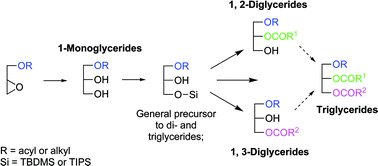Regioselective and stereospecific acylation across oxirane- and silyloxy systems as a novel strategy to the synthesis of enantiomerically pure mono-, di- and triglycerides†
Abstract
A trifluoroacetate-catalyzed opening of the oxirane ring of glycidyl derivatives bearing allylic acyl or alkyl functionalities with trifluoroacetic anhydride (TFAA), provides an efficient entry to configurationally homogeneous 1(3)-acyl- or 1(3)-O-alkyl-sn-glycerols. Selective introduction of tert-butyldimethylsilyl- (TBDMS), or triisopropylsilyl- (TIPS) transient protections at the terminal sites within these key intermediates secures 1(3)-acyl- or 1(3)-O-alkyl-3(1)-O-TBDMS (or TIPS)-sn-glycerols as general bifunctional precursors to 1,2(2,3)-diacyl-, 1(3)-O-alkyl-2-acyl- and 1,3-diacyl-sn-glycerols and hence triester isosters. Incorporation of a requisite acyl residue at the central carbon of the silylated synthons with a subsequent Et3N·3HF-promoted, direct trichloroacetylation across the siloxy system by trichloroacetic anhydride (TCAA), followed by cleavage of the trichloroacetyl group, affords the respective 1,2(2,3)-diacyl- or 1(3)-O-alkyl-2-acyl-sn-glycerols. Alternatively, a reaction sequence involving: (i) attachment of a trichloroacetyl fragment at the stereogenic C2-centre of the monosilylated glycerides; (ii) replacement of the silyl moiety by a short- or long-chain carboxylic acid residue by means of the acylating agent: tetra-n-butylammonium bromide (TBABr)–carboxylic acid anhydride (CAA)–trimethylsilyl bromide (TMSBr); and (iii) removal of the trichloroacetyl replacement, provides pure 1,3-diacyl-sn-glycerols. The TBABr–CAA–TMSBr reagent system allows also a one-step conversion of 1,2-diacylglycerol silyl ethers into homochiral triglycerides with predefined asymmetry and degree of unsaturation. These compounds can also be accessed via a two-step one-pot approach where the trichloroacetyl derivatives of 1,2(2,3)- or 1,3-diacyl-sn-glycerols serve as triester building blocks for establishing the third ester bond at preselected C3(1)- or C2-positions within the glycerol skeleton at the very last synthetic stage. In all instances, the target compounds were produced under mild conditions, in high enantiomeric purity, and in practically quantitative yields.


 Please wait while we load your content...
Please wait while we load your content...